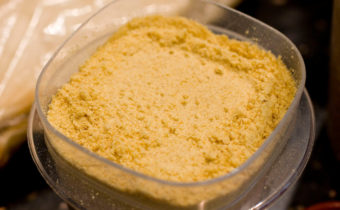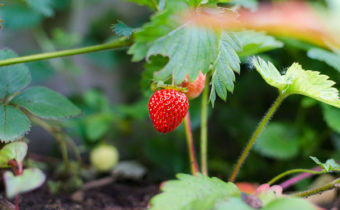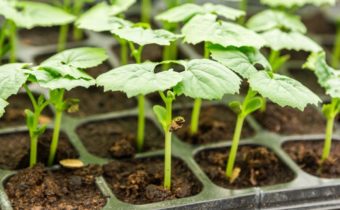Tomato "Orange Strawberry": delicious orange giant
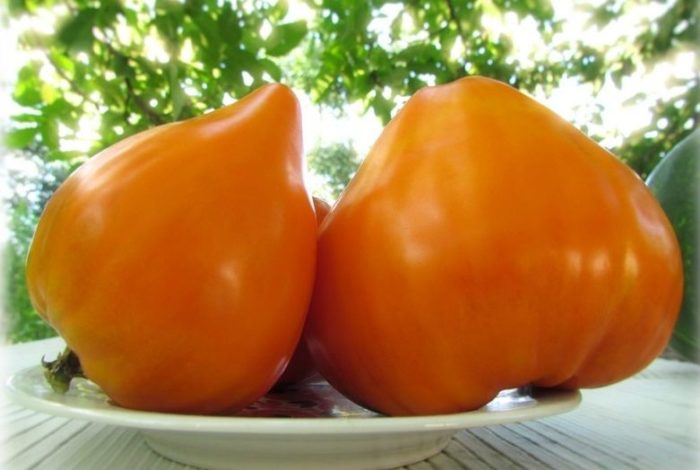
In one of the reviews about this tomato, one word was said: “Bomb!” From the emotions and delight, the author had no words on how pleased his harvest and the taste of large fruits were of a bright orange heart-like color, only rounded.
general information
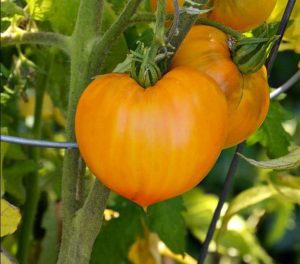 Tomato variety "Orange Strawberry" is popular among lovers of tomatoes. On forums and websites about tomatoes, only admiring reviews about him. A tomato has been grown for a long time: avid gardeners and gardening veterans have it in their arsenal, sharing seeds with neighbors and friends. In every way they protected and preserved for decades the delicious orange giant and proud of it.
Tomato variety "Orange Strawberry" is popular among lovers of tomatoes. On forums and websites about tomatoes, only admiring reviews about him. A tomato has been grown for a long time: avid gardeners and gardening veterans have it in their arsenal, sharing seeds with neighbors and friends. In every way they protected and preserved for decades the delicious orange giant and proud of it.
The second life was given to the variety by the now popular Internet shops, private farms selling "their own" seeds. Some of them are confused and confused buyers. Now lovers and even sellers confuse two varieties of “orange strawberry” and tomato “German orange strawberry”.
No one can say where the name “Orange Strawberry” came from, 30 years ago there was no such sort, but there were other names for a similar species. The gardeners themselves became breeders: keeping the best specimens for seed, they achieved the best qualities of this species, and those who sell seeds improved the variety and gave it a new name.
Characteristic and description
Let's get acquainted with the "Orange Strawberry" closer:
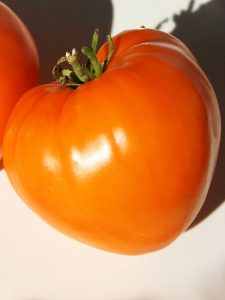
- It belongs to the indeterminate type, that is, it is a vine that will grow endlessly, and the growth depends on the capacity of the greenhouse. According to some reports, grows up to four meters.
- The average period of ripening, that is, from germination to the first harvest is 100-110 days.
- Suitable for growing in greenhouses and open ground under the shelter.
- In the brush, 4–6 large fruits are tied up, orange in color from 300 g to 700 g, but there is information that 1 kg of fruits were received in the greenhouse, but 1–2 pieces were formed in the brush.
- Stretched fruiting, in good greenhouses fruits until October.
- Fruits do not crack on the hand.
- Requires good support for the barrel and garter brushes.
- Ties fruit during high temperatures.
- High-yielding - up to 6 kg from one bush, you can collect the most delicious tomatoes salad destination.
- Keep no more than two weeks in ripe form.
- Transportation is possible if you put the tomatoes in one row so that they do not touch each other.
See also: Tomato "Honey drop." Characteristics and description of the variety
Description of the bush
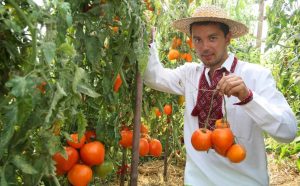
- The bush is powerful, from 1.8 to two meters high in open ground and 2.5–4 meters in greenhouses.
- Brushes are beautiful, look like bouquets with complex double flowers. From 4 to 6 large fruits are fastened, which is interesting, on the upper hands the fruits are as large as the bottom.
- Requires formation: be sure to pinch and tie.
Fruit Description

- Tomatoes are collected in strong beautiful brushes of 3-6 pieces.
- The fruits are large, most often weighing about 500 g, but the mass depends on the number of tomatoes per branch and varies from 300 to 700 g.
- The flesh is fleshy, orange in color, sugary, oily, with a small amount of small seeds.
- The taste is sweet with a fruity touch.
- The shape of the tomato resembles strawberries with an elongated tip; it resembles a rounded heart, the sides are smooth, glossy, slightly noticeable ribbed in the stem.
- The skin is thin, has a shade from bright yellow to dark orange color depending on the stage of maturity and lightness of the bush.
Disease and Pest Resistance
Tomato "Orange Strawberry" judging by the reviews and photos of the yield in September and October is almost not subject to disease, if you follow simple rules and prevention.
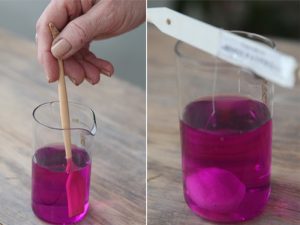
- Before planting, seed the seeds in a solution of potassium permanganate or “phytosporin”.
- Seedlings regularly spray them with antifungal and antiviral agents once every 2 weeks: one of the modern and safe ones is “phytosporin”.
- Air the room after watering.
- Do not thicken the planting: tall varieties should be planted in a greenhouse no more than 3 pieces per 1 sq. M., In time to remove the leaves from the bush.
Advantages and disadvantages
After reviewing the tomato "Orange Strawberry", a description of the variety which is presented above, we can distinguish its disadvantages and pros.
Pros:
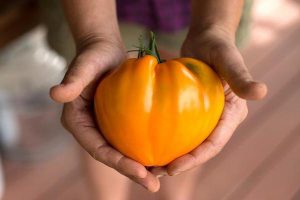
- Proven yield variety.
- Fruits of orange color: they have a high content of the substance "beta-carotene" - the "elixir of youth", which is the strongest antioxidant. Thanks to their color, the fruit is safe for people with allergies.
- Tomatoes are low in acid, so people with GI diseases can eat them.
- Of all the yellow fruit, it is the most delicious variety: a hint of fruit and oiliness of the pulp.
- Do not crack with high humidity, full sticking in the heat, not subject to disease.
- Great raw, and you can also make mashed potatoes and juices.
Minuses:
Minuses, even with a big stretch, no one could provide.
Therefore, the variety is worthy to be grown.
See also: We grow tomato seedlings for the greenhouse
Features of growing
Tomatoes "Orange Strawberry" does not require special growing conditions.
The variety is of the middle-ripening type, therefore it should be sown not earlier than March, calculating dates for its region.
After sowing the seeds, remove the container to a warm place, not lower than 25 ° C and as soon as the seeds are full, rearrange them to light and maintain the temperature at 15–16 ° C for 7 days, then raise the temperature to 20–22 ° C.
When the first two leaves appear, transplant the seedlings into bigger boxes or separate containers, not forgetting to feed them with superphosphate and potash fertilizers.
In indeterminate varieties, the first flower brush appears no earlier than the eighth leaf, so the main task is to prevent the seedlings from stretching.
To enhance the growth of roots, plant in high pots, and as the bush grows, sprinkle the ground. The earth is important too: it must be fertile and neutralized.
Plant in the prepared wells: 1 l of sifted ash, 1 l of humus, two spoons of superphosphate. Well shed well and sprinkle with mulch on top.
For two weeks, do not do any fertilizing and plant treatments.
See also: Autumn preparation of the greenhouse for growing tomatoes
- yield increase;
- stimulation of growth points;
- increase the sugar content of fruits;
- yield increase by 15–20%.
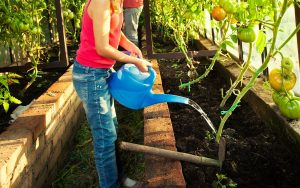 Watering a tomato is not a difficult science, but an important one!
Watering a tomato is not a difficult science, but an important one!
Watering plentifully, but infrequently, and the mulch will retain moisture longer, not allowing it to evaporate.
Fertilizing for large-fruited varieties is very important, but not done during fruiting.
Tomatoes will perfectly respond to root feeding:
- manure infusion: take 1 liter per 10 liter of water, add 1 liter of ash and a tablespoonful of superphosphate to it and pour 0.5 liter under each root, to do when increasing the mass;
- during fruiting, you can feed the plants for a uniform ripening of fruits with this solution: 1 tablespoon of nitrophos and 1 teaspoon of sodium humate per 10 liters of water, add 0.5 liters to the root.
Nothing complicated to get a tomato - “bomb”! The variety is good in all respects and your love will return in the form of an “orange strawberry”, so much like a big sunny heart.
Video: The most delicious yellow-fruited tomato variety - “Orange Strawberry”



